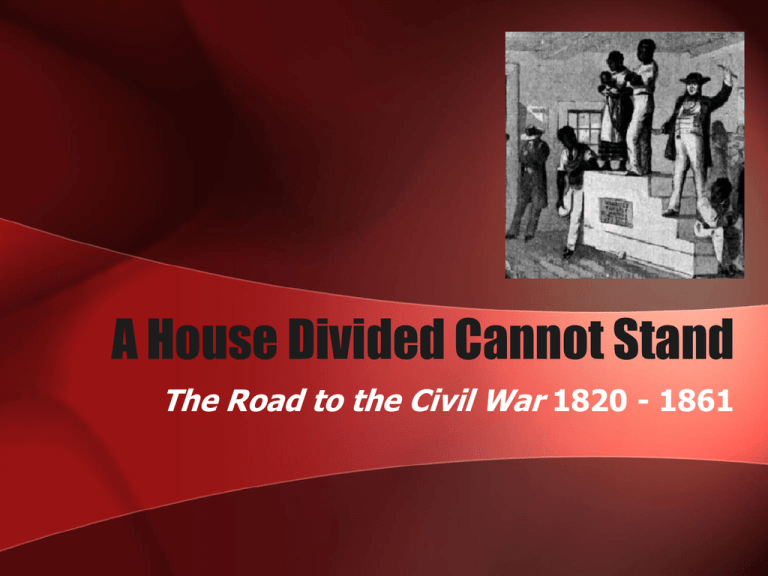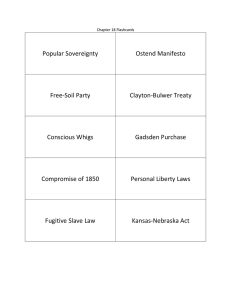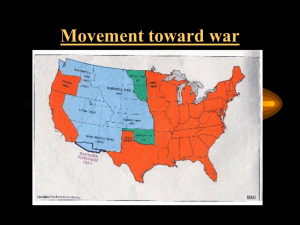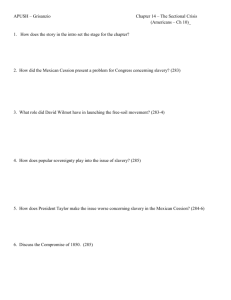A House Divided Cannot Stand
advertisement

A House Divided Cannot Stand The Road to the Civil War 1820 - 1861 Past efforts to curb slavery • 1787 - Banned slavery in the Old Northwest. • 1808 – Prohibited the continuation of importing slaves. • 1820 – Missouri Compromise • 1846 – Wilmot Proviso Past Catalysts for Slavery • Popularity of TRICkS crops • Cotton Gin in the 1790s • Westward expansion – Acquisition of land from Mexico THE NORTH SLAVERY •The viability of the Union •The strength of Democracy •Democratic Ideals What are the reasons for the Civil War? THE SOUTH SLAVERY •Political power balance •Difference of cultures and economies •SelfDetermination/State Power What are the reasons for the Civil War? S.T.A.P.L.E.R. • • • • • • • SOCIAL TECHNOLOGY ADMINISTRATION POLITICAL LEGAL ECONOMIC RELIGIOUS TECHNOLOGY evaluation of antebellum South • Invented in 1793 • Led to an economic spiral: – More slaves and land to plant more cotton, which needs… ECONOMIC evaluation of antebellum South Fuel for a international economy • 1840 – half of U.S. export value was from cotton • Britain's labor market depended on this raw material • Can the world’s economy afford to abolish American slavery? SOCIAL evaluation of antebellum South • • • • • • plantation owners small slaveholders independent white farmers poor whites free blacks black slaves SOCIAL evaluation of antebellum South PLANTATION OWNERS • South ran as an oligarchy – In 1850, less than 2,000 families owned over 100 slaves • Lived at the “big house” on large plantations – Mistresses would command large household staffs. SOCIAL evaluation of antebellum South SMALL SLAVEHOLDERS • Only ¼ of all white southerners owned slaves. • Typically small farmers SOCIAL evaluation of antebellum South INDEPENDENT FARMERS • Over six million non-slave owning southerners • Backcountry and mountain regions • Did not participate in the market economy. POOR WHITES • “Poor White Trash” • Seen as lazy and shiftless Why did nonslaveholding whites support slavery? • The “American Dream” • Racial Superiority • Compete with freed blacks for jobs SOCIAL evaluation of antebellum South FREE BLACKS • 250,000 free blacks in the South by 1860. • Why freed? – Idealism from the Revolutionary War – Mulattoes from white planters and black mistresses • Strong in New Orleans • Unpopular in the North and South SOCIAL evaluation of antebellum South BLACK SLAVES • • • • • • By 1860, 4 million slaves Seen as an economic investment Families were divided Education a crime Blend of religion Sabotaged work as rebellion Southern Defenses for Slavery • Greek and Roman cultures each featured slavery • Essential to the southern economy • Preferable to the "wage slavery" of the North • Slavery was ordained by God, permitted in the Bible ("Slaves, obey your masters") • Beneficial to the blacks who had traded the barbarism of Africa for the blessings of security and Christianity RELIGIOUS evaluation of antebellum South • Slave owners and slaves both used the Bible to support their views. • Northern abolitionists also used the Bible to support their cause. – Methodist Episcopalians split in 1844 – Baptists split in 1845 S.T.A.P.L.E.R. • • • • • • • SOCIAL TECHNOLOGY ADMINISTATION POLITICAL LEGAL ECONOMIC RELIGIOUS Political Road to War over Slavery • PUBLIC POLICY ISSUES, CONTROVERSIES and LAWS ASSOCIATED THEREWITH • Federal Supremacy vs. States’ Rights (nullification, personal liberty laws) • Expansion of slavery in the territories and Caribbean – – – – – – – – – Missouri Compromise 1820 Wilmot Proviso 1846 Free-Soil Party 1848 Popular Sovereignty 1840s Compromise of 1850 Fugitive Slave Act 1850 Death of the Whigs in 1852 Ostend Manifesto 1853 Kansas-Nebraska Act 1854 Missouri Compromise of 1820 • Maine admitted free • Missouri admitted slave • Maintains balance between slave and free states in the Senate • Territory north of 36°30' in LA territory to be free of slave; south of 36°30' can be slave • Jefferson called it the “death knell” of the Union. Wilmot Proviso (1846) • Congressman David Wilmot proposes that there be no slavery in any land taken from Mexico • Passes House, fails in Senate • Represents growing divide between North and South Free Soil Party (1848) • Platform: Keep slavery out of territories • Van Buren gets 10% of vote • New York votes ensure Taylor’s election – Whig – Sugar plantation owner from Louisiana Popular Sovereignty (1840s) • Do not confuse this popular sovereignty with popular sovereignty that is a fundamental principle of constitutional government in the U.S. (i.e., the people are sovereign). • This popular sovereignty refers to the right of the people in a territory to decide whether or not to have slavery. (Sen. Stephen Douglas, IL) • This is simple—do not think too much about this. Compromise of 1850 Five laws: 1 California admitted as free state (free now majority in Senate) 2 Texas boundary adjusted for $10m to Texas 3 Slave trade abolished in D.C. 4 Mexican cession organized as New Mexico and Utah territories on basis of popular sovereignty 5 Strong fugitive slave law Fugitive Slave Law of 1850 • Northerners were obligated to help slavecatchers return fugitive slaves • Prompts Northern states to pass “personal liberty laws” to prohibit enforcement of the Fugitive Slave Act • Harriet Beecher Stowe writes Uncle Tom’s Cabin • Whig party breaks up in 1852 over Fugitive Slave Act Death of the Whigs • Whig president Fillmore supported the Fugitive Slave Act, alienating many Northern Whigs. • The Whig party divided, and by 1854 was no more, with Northern Whigs joining the new Republican party. Ostend Manifesto (1854) • President Pierce, a Southern expansionist, wants to buy Cuba from Spain--Spain won’t sell • Pierce diplomats meet in Ostend, Belgium and prepare report suggesting a seizure of Cuba is Spain won’t sell • This “Ostend Manifesto” is made public and is an embarrassment to Pierce and slaveholding interests • Heightens Northern fears and tensions Kansas-Nebraska Act of 1854 • Senator Stephen Douglas (IL) proposes that remainder of Louisiana Territory be divided into Kansas and Nebraska territories with popular sovereignty to determine status of slavery • Free-soilers angered by this repeal of Missouri Compromise line 36°30' • Republican Party is formed, and Northern Whigs join • Leads to “Bleeding Kansas” • Demonstrates sectional divide is becoming critical Uncle Tom’s Cabin (1852) • Written in response to the Fugitive Slave Act, the book is highly critical of slavery • More in the North oppose slavery • Many books attacking Stowe’s work and defending the South were written in response (Aunt Phyllis’s Cabin) • The book enflamed passions on both sides and is, arguably, the most influential book in U.S. History Bleeding Kansas (1856) • Bleeding Kansas • Free-soilers and slavers moved to Kansas and fought to establish control • By 1856, fighting broke out as both sides vie for power--“Bleeding Kansas” • Fighting in Kansas “foreshadows” coming of the Civil War • John Brown gets his start here! The Lecompton Constitution of 1857 • Pro-slavery faction at Lecompton, Kansas submits constitution to Congress for admission to U.S.—Congress refuses • Northern Democrats oppose, including Sen. Douglas (which costs him Southern Democratic support) • Lecompton Constitution crisis signals growing rift between North and South • [Kansas admitted as a free state in 1861] Dred Scott v. Sanford (1857) • Pro-slave Chief Justice Roger B. Taney rules that Africans are not citizens and can’t sue • Slaves have no rights • Congress cannot prohibit slavery in territories (thus the Missouri Compromise was unconstitutional) • Decision enflamed abolitionists and many Northerners, while lifting the hopes of proslavery forces • Tensions increase even more • [14th Amendment (1868) declares blacks to be citizens, thus overcoming Dred Scott] Lincoln-Douglas Debates & Freeport • In Illinois Senate race, 1858, Lincoln and Douglas have debates (Lincoln lost election) • At Freeport, IL, Lincoln got Douglas to admit that if a people in a territory voted down slavery, it would “Stay down.” • Douglas’s position was consistent with popular sovereignty but inconsistent with Dred Scott • Douglas lost support from Southern Democrats, further dividing the Democratic Party (again, remember these splits as “foreshadowing” the Civil War) The Democrats Splinter into Factions 1860 • The Democrats broke up before the election of 1860: Northern Democrats backed Douglas, Southern Democrats backed John C. Breckenridge, and border states (slave states next to the North) backed John Bell of Kentucky • The fracturing of the Democrats opened the door for Lincoln and the Republicans • The breakup of the Democrats in 1860 foreshadowed the coming of the Civil War in 1861




